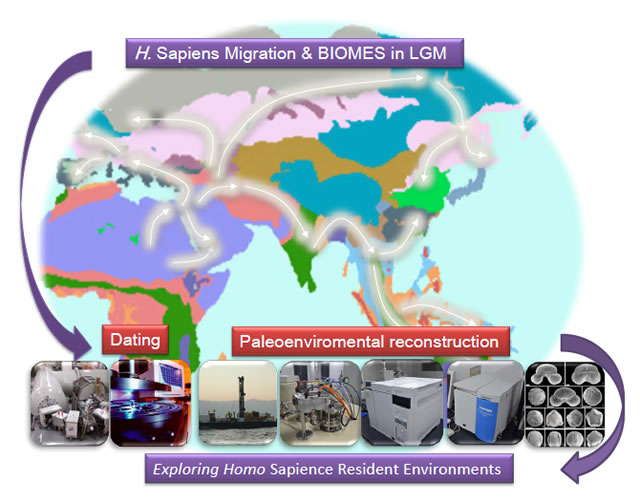A03: Changing climate and resident-environment in the migrations and expansions of Homo sapiens across the continent of Asia
Research Team A03
Changing climate and resident-environment in the migrations and expansions of Homo sapiens across the continent of Asia
- Team Leader
-
- Hiroyuki Kitagawa, Professor
Environmental Sciences, Chronology, Institute for Space-Earth Environmental Research, Nagoya University, Japan
- Hiroyuki Kitagawa, Professor
- Co-investigators
-
- Toshiyuki Fujiki, Lecturer
Palynology, Faculty of Science, Okayama University of Sciences, Japan - Fumiko W. Nara, Researcher
Climatology, Geochemistry, Geology, Institute for Space-Earth Environmental Research, Nagoya University, Japan - Hitoshi Hasegawa, Lecturer
Sedimentology, Paleoclimatology, Faculty of Science and Technology, Kochi University, Japan - Yasuhisa Kondo, Associate Professor
Geoinformatics (GIS), Archaeology, RIHN Center, Research Institute for Humanity and Nature, Japan - Toru Tamura, Researcher
Sedimentology, Geomorphology, Chronology, National Institute of Advanced Industrial Science and Technology, Japan - Takehiro Miki, PhD student
Institute of Near Eastern Archaeology, Free University of Berlin, Germany - Taichi Kuronuma, PhD student
Tokyo Metropolitan University, Japan - Masako Yamane, Researcher
14C dating, Geochemistry, Institute for Space-Earth Environmental Research,
Nagoya University, Japan - Christian Leipe, Researcher
Palaeoecology, archaeology, Environmental Sciences, Chronology, Institute
for Space-Earth Environmental Research, Nagoya University,
Japan/Palaeoecology, archaeology, Institute of Geological Sciences, Free
University of Berlin, Germany
- Toshiyuki Fujiki, Lecturer
- Overseas Collaborators
-
- Mordechai (Moti) Stein
Geochemistry, Geological Survey of Israel, Israel - Jaesoo Lim
Quaternary Science, Geochemistry, Korea Institute of Geoscience and Mineral Resources (KIGAM), Korea - Dang Xuan Phong
Geography, Geochemistry, Institute of Geography, Vietnamese Academy of Science and Technology (VAST), Vietnam - Niiden Ichinnorov
Pollen analysis, paleovegetation reconstruction, Institute of Paleontology and Geology, Mongolia - Marco Madella, Professor
Department of Humanities, Pompeu Fabra University Archaeobotany, Environmental archaeology - Carla Lancelott, Researcher
Department of Humanities, Pompeu Fabra University Archaeobotany, Environmental archaeology
- Mordechai (Moti) Stein
- Invited Researchers
-
- Hiroki Oota, Associate Professor
School of Medicine, Kitasato University
- Hiroki Oota, Associate Professor
Research
Research Objectives
Homo sapiens ventured out of Africa, spread out to the whole world in the late Pleistocene when intense climatic changes were occurred in a cyclic form. There are various opinions on the migration route of the Homo sapiens toward Asia, but a fierce trip for survival and prosperity is supposed. In the research project (PaleoAsia-A03), we aim to understand the transition of climate and residential environments changing in the migrations and expansions of Homo sapiens across the continent of Asia (PaleoAsia). To reconstruct the climate and residential environments, PaleoAsia-A03 plant to conduct systematically field survey and a variety of analyses of archaeological remains. The results will be combined with the local to regional climatic changes, and then discussed at a point of view of environment history about how Homo sapiens adapted to a momentarily change in residential environments, and the created unique cultures, and what was driving force and inevitability for the migrations and expansions of Homo sapiens across the continent of Asia.
Research method
We conduct a topographical and geological survey around the archeological sites and a variety of analyses of archeological remains to reconstruct resident-environments of Homo sapiens in PaleoAsia. In reference to an substantial data about the dispersal patterns of Homo sapiens into Asia (provided by collaborated research team; PaleoAsia-01 and -02) and a mathematical based PC simulation of human migrations, we select some key archeological sites on the route of the migrations and expansions of Homo sapiens across the continent of Asia, and promote systematic survey and a variety of analyses of archaeological chemistry such as 14C and OSL dating, isotope analysis, geochemical analysis, sedimentological analysis pollen and macrofossil analyses and etc. We also turn the sediment samples from wetlands and lakes into an object of analysis to understand the geographical pattern of the past climatic and environmental changes near Homo sapiens residence site in PaleoAsia. The information of resident-environments and local-regional climatic changes will be integrated to assess the driving force and inevitability for the migrations and expansions of Homo sapiens across the continent of Asia.
